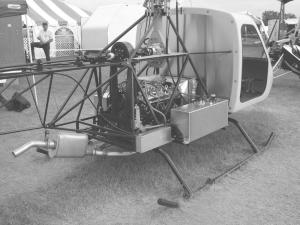2006 - Volume #30, Issue #4, Page #30
[ Sample Stories From This Issue | List of All Stories In This Issue | Print this story
| Read this issue]
Do-It-Yourself Helicopter Designed For Farm Use
 |
"For the price, no other helicopter kit can match the performance of this machine," says Ron Willocks, Pawnee Aviation, Inc., McCook, Neb. "We have three items that no one else on the market has: A very high power-to-weight ratio, a rotor system designed for high altitude, and a very high gross weight."
It measures 8 ft. 2 in. high, 32 ft. 3 in. long, and has a 30-ft. dia. rotor. It cruises at 85 mph and, with two 15-gal. fuel tanks, has a range of 250 miles. Payload capacity is 880 lbs. Power is supplied by a four-stroke, 8-cyl. high performance gas engine rated at 355 hp. The tail rotor consists of a direct-drive system using a driveshaft.
The cockpit has two seats and controls. In order to keep the price down, the kit comes with some conventional components, including a standard fuel racing tank and an automotive muffler.
Building time is estimated at 150 to 200 hours. It operates for less than $30 per hour.
The Chief sells for $67,500.
"It's built like a tank and has unheard of performance for the price," says Willocks. "We designed it like a farm machine. In fact, one of our advisors on this project was an Illinois inventor of farm equipment who builds helicopters as a hobby. We like to think of this helicopter as a flying combine, because it uses a lot of farm-type sealed bearings that will never need maintenance."
According to Willocks, the helicopter has outstanding power for its size because of its high horsepower and high lift blade design. "We worked with the National Aeronautic Space Administration (NASA) and two universities on the rotor blade design. The rotor blade is made from carbon fiber, which eliminates the potential for metal fatigue."
The high payload capacity is important to farmers, says Willocks. "If your cattle are stranded, you can use this helicopter to sling a load of hay bales to them.
"Other helicopter kits have a lower payload. We looked at those and said, ŠIf you can't take two 250-lb. people and a full load of fuel, what's the point?"
He recently displayed the helicopter at the recent 3I show near Great Bend, Kansas. "One farmer at the show told us he's interested because he has 34 center irrigation pivots and is tired of driving to his pivots. Another farmer with several thousand acres of milo and corn and a big cow-calf operation said he plans to use our helicopter to check on his cows during calving. He has been a helicopter pilot for many years, and says cows get so used to the helicopter that he can fly close enough to read their tags."
Willocks says they've gone to extremes to make sure this helicopter is high quality and reliable. "When we design a part, we do structural stress analysis on the computer just like Boeing does on their aircraft."
The dual engine/rotor tachometer uses LED lights instead of needles or a digital readout. "When the engine and rotor are at the correct operating rpm's, you'll see a green LED light so you know you're good to go without having to figure anything out. There's a built-in high and low warning horn, so if the engine rpm's go dangerously low an alarm will let you know."
Willocks says they used all aircraft-grade materials in building the helicopter. "The General Motors Ram Jet racing engine is actually based on a conventional small block, V-8 Chevy engine, which is one of the most dependable engines ever made. The engine is built for racing and high rpm's."
The engine belt-drives a pair of driveshafts, which drive the main rotor and tail rotor. The sheave on the secondary shaft contains a Sprague clutch. "If the engine ever stops the Sprague clutch instantly disengages the rotor system, allowing auto-rotation for a safe and controllable descent to a normal landing," says Willocks.
If the engine ever should fail, there's a built-in 2-second reaction time so you can do an auto rotation to get the helicopter going forward and down, so the upflow of air will keep the rotor turning and fl

Click here to download page story appeared in.

Click here to read entire issue
To read the rest of this story, download this issue below or click here to register with your account number.




